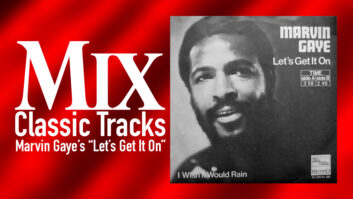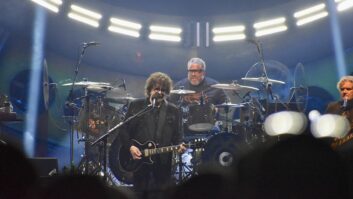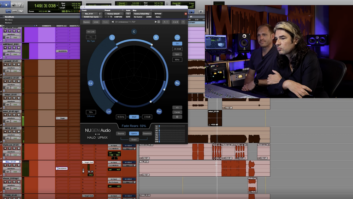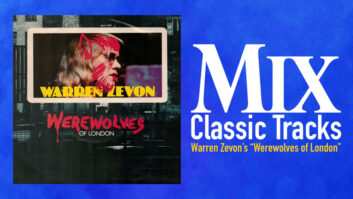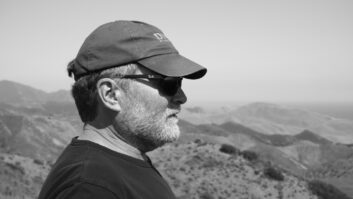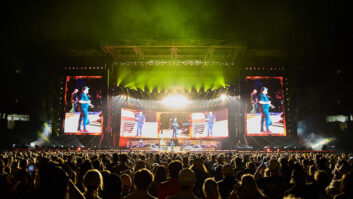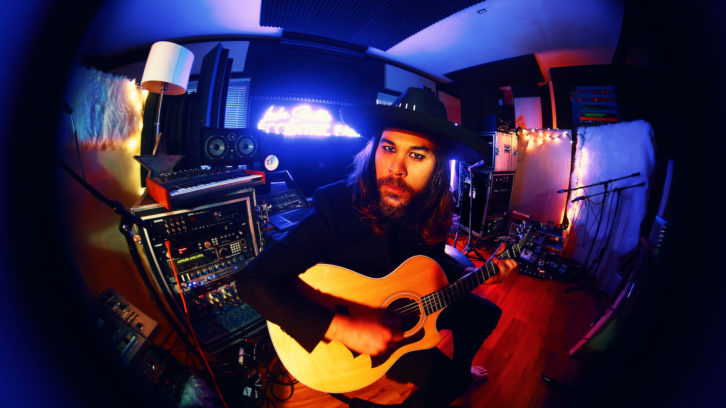
Luke Steele plays a lot of different characters. He is perhaps best known as “The Emperor” in his technicolor USC marching band-meets-Cirque du Soleil group, Empire of the Sun. He is also a cyberpunk of the underworld in Dreams, his project with Daniel Johns of Silverchair, and he’s a grounded space traveler in H3000, his collaboration with MSTR Rogers. Two decades ago, he was a country-influenced troubadour, the central figure of The Sleepy Jackson.
On his latest album, Listen to the Water, his first as a solo artist and under his own name, Steele is yet another character. This time, he is a lone guitar-slinger, living in a log cabin, in a forest next to a lake in Northern California, secluded from society, holed up in his Eccentric Farm studio. Steele moved to this remote spot with his family two years ago, after living in Santa Monica, where he had transplanted from his native Australia.
In this two-car garage-turned-home studio, which is reinforced with insulation panels and acoustic foam, Steele has a robust but efficient setup. After years of recording, he has a streamlined understanding of what works for him, and how to use it.
Listen to the Water revolves around Steele’s vocal rig, a Deckard’s Dream synthesizer (a relatively recent boutique remake of the Yamaha CS-80) and two Taylor guitars, one of which is a 414 CE. Says Steele, “I also have the Taylor T57 Standard guitar, which is like an electric and reminds me of Lindsey Buckingham. He always uses an acoustic, which is a hybrid between a classical and acoustic. The strings are kind of slinky, and it has lipstick pickups. You just plug it in, and it’s this electric/classical/acoustic hybrid that gives that really crispy guitar sound.”
Steele has fashioned a vocal booth in a corner of Eccentric Farm. Here, he has his Telefunken ELA M 251E microphone. His vocal chain goes through a Neve BAE 1073 preamp, a TubeTech CL1B, (“this compressor has a really, blanket-y, warm, creamy kind of sound that works with my rugged voice”) and an Inward Connections TSL- 4 Vac Rac limiter. In the booth, Steele only has access to a monitor and compression so he can record and change the settings. This separation, he says, allows him to tap into more emotion when he’s singing.
“I trusted instinct with the vocals; they were all first or second takes,” says Steele. “The vocal is the storyteller. You have to be able to hear the vocalist’s heart. You have to hear the passion. It’s got to be clear. I want the vocal as dry and close as possible so you can hear the person. I hate when it’s lo-fi. You can’t dress it up. You can put compressors on it, but it needs to start with real high fidelity.”
The songs on Listen to the Water begin with guitar patterns, a couple of bars, or maybe a loop. Steele then writes the lyrics, cuts the vocal, returns the following day, and finishes the song. Each song was completed in two days.
He says, “When I’m natural and it’s live and it’s close and I don’t overthink it, it’s great. That’s when I sound the best. I either sound great on take one or on take 472. In Empire, we do vocals for months. One song, 12 layers of falsetto, 12 layers of my full voice, 12 layers with Yoko Ono voice, and together that makes a sound. It was great to just sing a song, and cut it.
“That’s a big thing I’ve learned over the years,” he continues. “Always have the best mic set up exactly, ready to go. I have 8,000 different tones in my voice. It will never sound the same. When my heart’s not in the take, it sounds like nothing. It sounds invisible. It only works when it’s real, so I’ve got to get it.”
Once the vocal is captured to Steele’s satisfaction, the vocal effects chain is all outboard: Eventide H3000 and a Bricasti M7 Reverb. In fact, the majority of Steele’s studio is hardware, which he records into a Pro Tools rig.
“Having too much in the box gives me too many decisions,” he says. “The drum machines I’m using are old, dusty drum machines like the ones you get on the Hammond organ, and a Roland CR-78. I’m pretty old-school like that. I still love turning the dials. It just sounds better to me. If I have a soft synth, I’ll literally change the setting for three months. I’ve always liked committing, printing stuff. You throw it down and you build it. It becomes like a painting.”
The “painting” approach, which is something Listen to the Water shares with Steele’s Empire of the Sun albums, began in songwriting sessions in Nashville, Thanksgiving 2019. There, Steele tapped into the talents of renowned pedal steel player, 72-year-old Dan Dugmore. He also enlisted ubiquitous percussionist Brian Kilgore in Los Angeles. Initially working in-person, and later, remotely, Steele would then manipulate the sounds he had captured from them through his Eventide unit, reversing and pitch shifting, to create the psychedelic cowboy swimming underwater sounds of the album.
“I only use five of the settings on the Eventide to keep the ingredients really focused,” says Steele. The idea is to create a melody with the pitching that fits in with the acoustic guitars. For the guitars, Steele alternates between recording DI or with Josephson C42 condenser mics.
Even with his mainly outboard studio, there are a few plug-ins Steele relies on. Among these are FabFilter Pro Q3, Waves Renaissance Vox and Eventide’s Blackhole and Physion, all primarily for reverb. Says Steele of FabFilter, “While you’re playing something, you press the plug-in and it shows you which frequencies are the bad ones, the ones that are spiking. That, to me, is a genius plug-in because you can dial it immediately. I use it with my vocal heaps because I could have my vocals super loud, but if the vocal is really light, which a lot of them are, I can take out the special high ones and pinpoint the exact frequency. The discovery of that plug-in is dope.”
Listen to the Water was wholly mixed by Steele. He credits his experiences with Empire of the Sun, as well as working on his father, Rick Steele’s, albums for his deft hand at mixing. “I grew up with this kind of music,” he says. “I’m good at painting with organic instruments. Good analog gear is so subtle, but the frequency is better. The microphones have to be really great so the signal is great.”
Steele uses the technique of turning the level way down on his Yamaha NS-10s, mixing so quietly that he can barely hear, which after some minutes, sharpens his hearing abilities and allows him to hear everything.
Still, when it came to mastering, Steele had Listen to the Water mastered, and remastered—12 times. “It was such a traumatic time,” he says. “All I’m dreaming about is a certain frequency, and it got ruined in the mastering. It’s just this small tone, but it was a feeling I had to chase. We got there in the end. The record should have been mastered in a week, and it took six months. That was my big Brian Wilson breakdown.”
In some ways, Steele is starting from scratch, and that feels great to him. “For so many years, I was trying to get to the point where my music sounded like it would fit into the palette of music that’s out there, that it wouldn’t sound unprofessional,” he says. I wanted to get back to where I can make the vocals as loud as Elvis. If I wanted to record six acoustic guitars at a time and then cut it, I could do it. I found that I love the process of being able to do what you did when you were young, when you were in art school and you didn’t care, before you became professional. I felt like I got back to that.”

